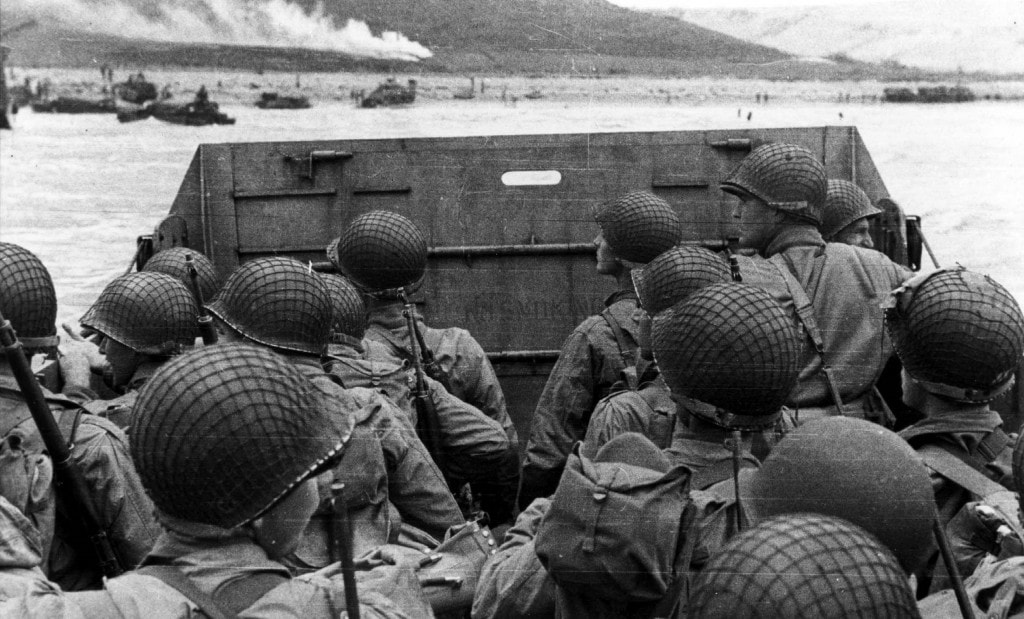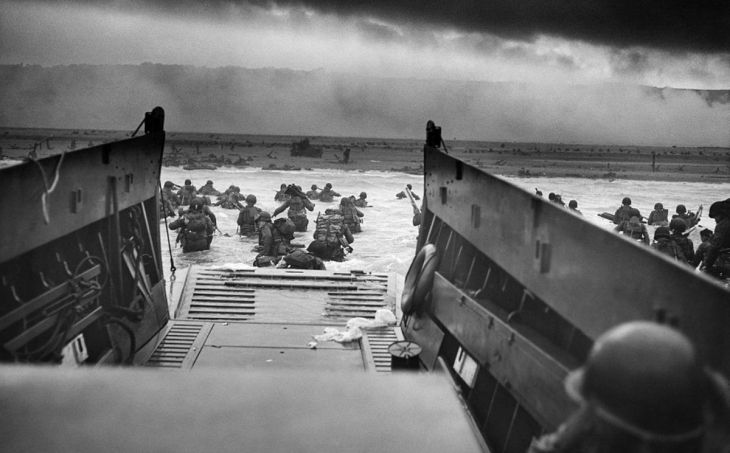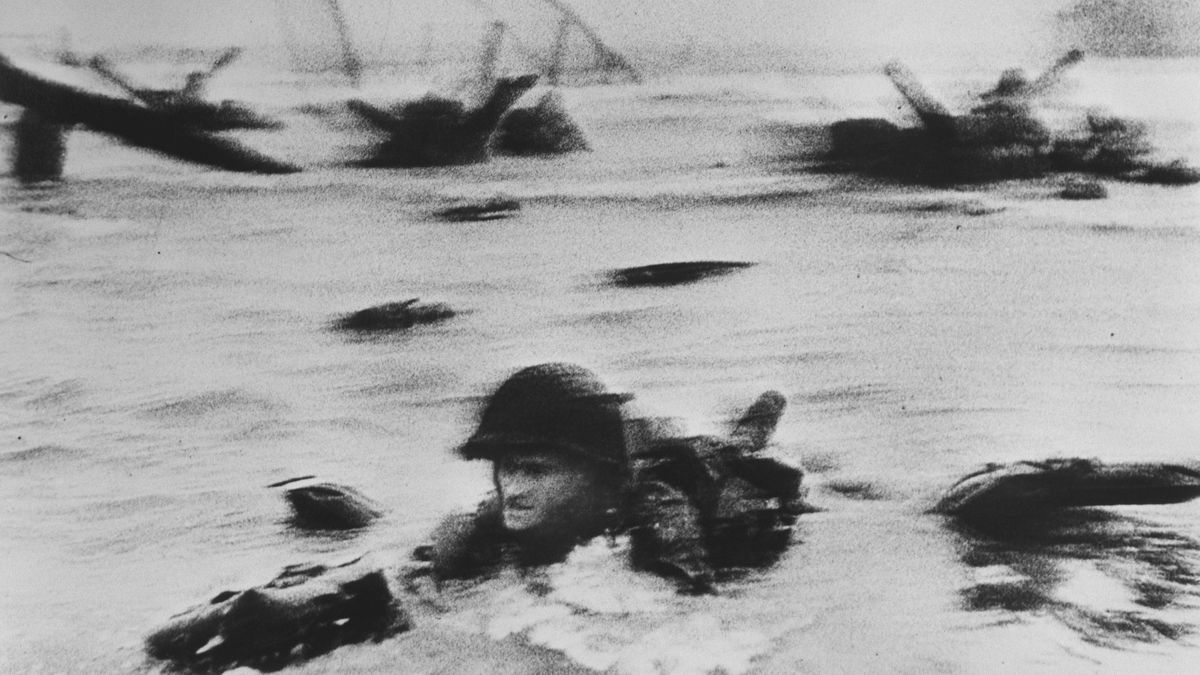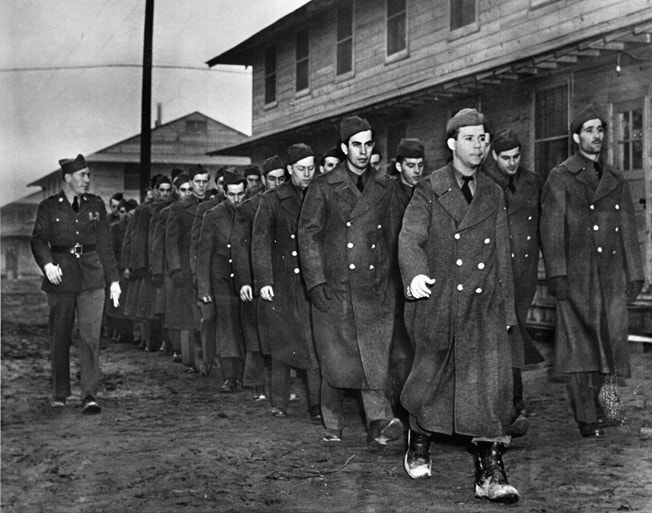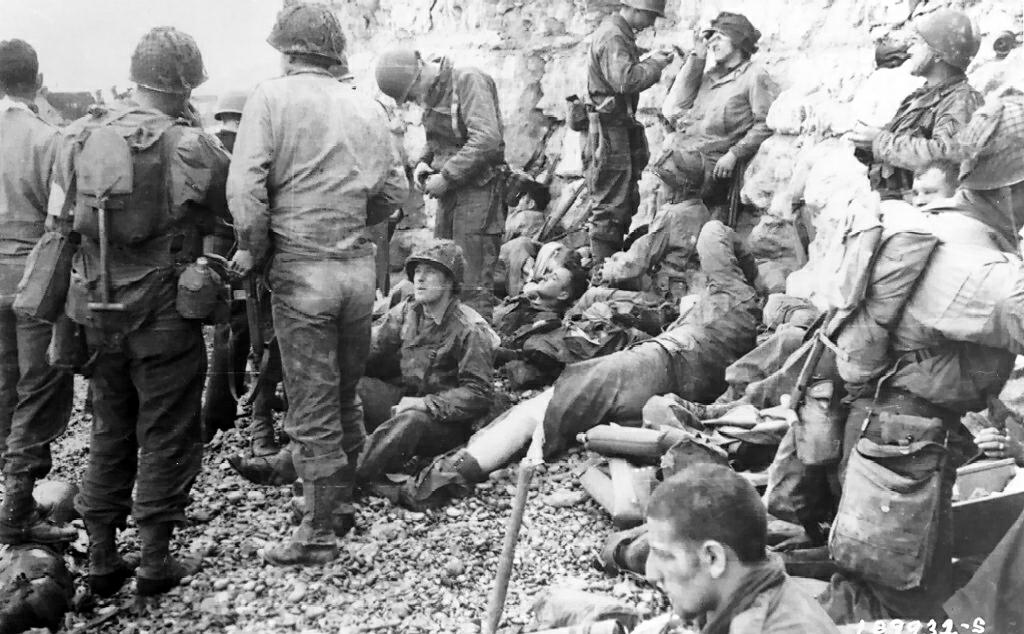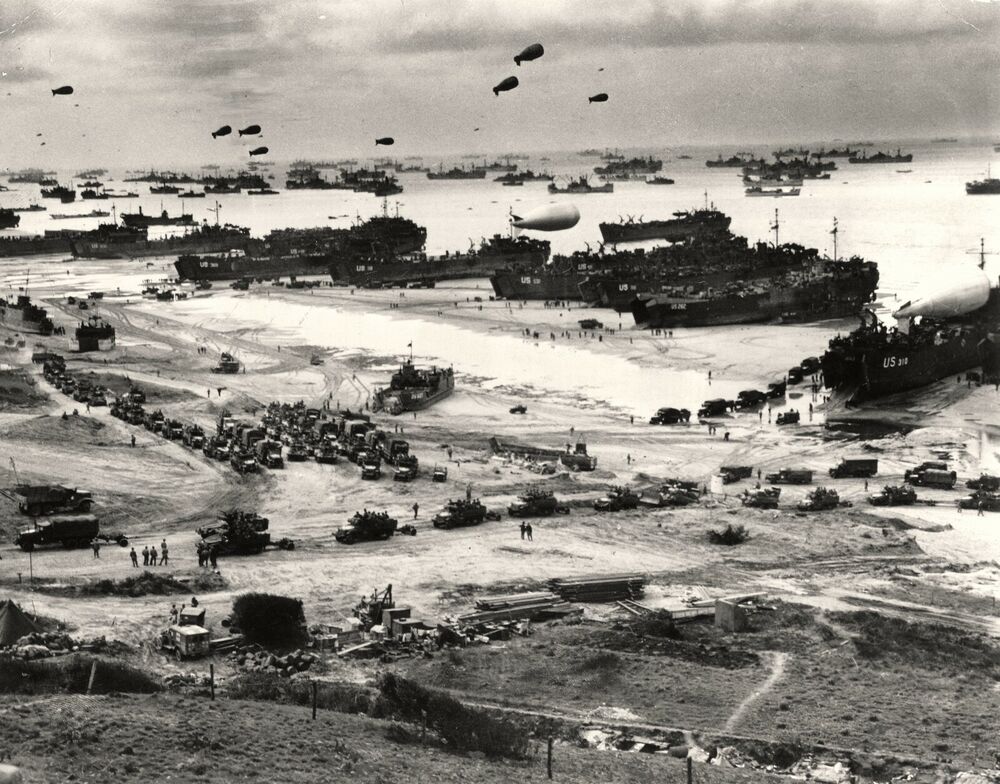|
The stories of individual people make history real in our imaginations. Norm Haskett strives to preserve those stories on his website The Daily Chronicles of World War II. Norm has kindly agreed to help us remember D-Day, June 6th, a day that should live in our consciousness as an critically important military victory that came at a staggering human cost. Norm gives us a brief overview of D-Day through photos and captions, and the story of the young men from Bedford, Virginia, part of the first wave of the historic invasion. Allied Naval forces crossed the English channel overnight June 6, 1944. Soldiers started landing at 6.30am on the coast of Normandy, France. Below: Coast Guard-manned flatbottom boat, better known as a Higgins boat, carries one of the first companies of U.S. solders to invade Omaha Beach. As the boat approaches, smoke on the bluff-restricted shore most likely emanates from seagrass set on fire by naval shells. Below: “Into the Jaws of Death” is the description of this image taken by Chief Photographer’s Mate Robert Sargent of the United States Coast Guard. Taken at 7:40 on the morning of June 6, it is one of the most widely reproduced photographs of the D-Day landings. It shows troops of Company E, 16th Infantry, 1st Infantry Division departing their landing craft and wading through waist-deep water towards the “Easy Red” sector of Omaha Beach. Earlier, U.S. Eighth Air Force heavy bombers were supposed to hit German defenses, and leave bomb craters to form instant foxholes, on the stretch of exposed beach, but the 13,000 bombs missed their target by 3 miles. The battle-hardened U.S. 1st Infantry Division joined by the untested 29th Infantry Division, advanced up Omaha Beach into 4 batteries of artillery, 18 antitank guns, 6 mortar pits, 35 rocket launcher sites, 8 concrete bunkers, 35 pillboxes, and 85 machine-gun nests. The two divisions suffered some 2,000 killed or wounded on Normandy beaches. Two-thirds of Company E, the soldiers seen in Sargent’s photograph, were among the casualties. German forward units reported to headquarters that the invasion had been halted at the water’s edge, though by 12:30 p.m. there were 18,772 men on Omaha Beach with thousands more arriving each succeeding hour. Among those soldiers in the first wave of the murderous assault on Omaha Beach were thirty-five young men from rural Bedford, Virginia. The men from Bedford had enlisted in the Virginia Army National Guard. When their unit was mobilized into the regular army the men were assigned to the untested U.S. 29th Infantry Division, Company A. Only nineteen Bedford Boys survived as the first wave hit the beaches that dreadful day. Three lost their lives later in the campaign. Thirteen sons of Beford survived the war to come home to their small town after the war. This is kind of personal story that helps us understand the war better, and that Norm shares on his website. Here he tells us how he the project started.  Norm Haskett Norm Haskett After thirty years as a history teacher and a technical writer, in retirement, freed of workplace demands, I chose to begin researching and writing on a subject that had long interested me: World War II. My carrier aircraft designer father and his two brothers who served in the U.S. Army were part of that “greatest generation” who answered their country’s call and gave us the world we live in today. Other people of that generation, in this country as elsewhere, lost their lives or survived, though millions were scarred mentally or physically by their wartime experience. Heroes, average Joes, victims, and villains—all these people had stories to tell us from the period—some still do. I decided I wanted to be a part in sharing them. On my website, The Daily Chronicles of World War II, I strive to preserve the stories of those who lived through that watershed era. Every day of the year I share a different story from a different theater of war and year, stories heroic or tragic or both. Of course heroism and tragedy can commingle in the same narrative.  The Bedford Boys: One American Town’s Ultimate D-Day Sacrifice by Alex Kershaw, showed me a perspective on heroism I’d never considered before. He quoted the sister of one of the thirteen Bedford survivors: “People say the men who died on the beach were heroes. I think the heroes are the ones who came back and had to live with it for the rest of their lives.” Soldiers who survived the Omaha beach landing faced 4 batteries of artillery, 18 antitank guns, 6 mortar pits, 35 rocket launcher sites, 8 concrete bunkers, 35 pillboxes, and 85 machine-gun nests. George A. Taylor, commanding the 16th Infantry Regiment on Omaha Beach, encouraged his men, most of them traumatized crossing the killing ground, to move up on to the bluffs where the German positions were, stating perhaps the obvious: “Two kinds of people are staying on this beach—the dead and those who are going to die.” Below, assault troops of the 3rd Battalion, 16th Infantry Regiment, U.S. 1st Infantry Division survived, gaining the comparative safety offered by the chalk cliff at their backs. Here they take a breather before pushing inland. Toward evening on D-Day itself the Omaha beachhead bustled with activity, having been reported safe for wheeled and tracked vehicles. Kitchens were set up and served beans and wieners and hash browns to the survivors of the nearly 40,000 men who were landed there that day. D-Day was the largest seaborne invasion in history. More than 4,100 landing craft and ships were deployed to Omaha and the other four assault beaches that stretched across a forty-mile front. By D+26 the vessels had delivered one million troops, 566,648 tons of supplies, and 171,532 vehicles. Below: With the beaches secured, badly needed tanks, heavy equipment, artillery, rifles and ammunition come ashore at Omaha Beach at low tide on D+3. Barrage balloons overhead were meant to deny German aircraft low-level airspace. Many people who lived through World War II waited until their senior years to tell their stories; sadly, most of them took their stories to their graves, having shared little if anything beyond telling at the most a few people.
Like Kershaw and other students of history, I desire to rescue as many stories of World War II as I can by discovering and recording them and then playing them back to a new audience on my website. My twin goals are to inspire this generation and caution its members about their responsibility to preserve and honor these legacies. It’s this desire that drives and energizes me every day. Thank you, Norm! I really appreciate the way you tell events day by day, including pieces from different perspectives and sources, all in one place. His website includes maps and photos, videos and books, as well as succinct snippets about the major campaigns and battles of the war. Click here for a map and overview of Operation Overload, which went down in history as the D-Day invasion. Comments are closed.
|
I'm fascinated to discover little-known history, stories of people and events that provide a new perspective on why and how things happened, new voices that haven't been heard, insight into how the past brought us here today, and how it might guide us to a better future.
I also post here about my books and feature other authors and their books on compelling and important historical topics. Occasionally, I share what makes me happy, pictures of my garden, recipes I've made, events I've attended, people I've met. I'm always happy to hear from readers in the blog comments, by email or social media. Archives
September 2023
Categories
All
|
